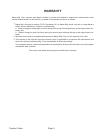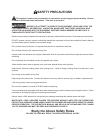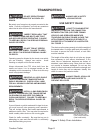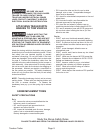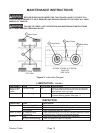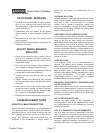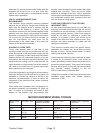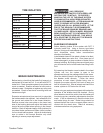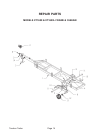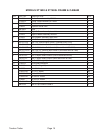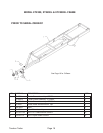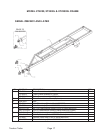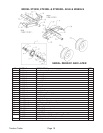
tread wear. By spacing the tire beads farther apart the
sidewalls are forced to flex in an area lower than
normal and this can result in circumferential carcass
breaks and/or separation.
USE OF A RIM NARROWER THAN
RECOMMENDED
This condition brings potential mounting problems
because the rim shield or flange cover molded into
most drive tire designs tends to interfere with the
seating of the tire beads on a narrow rim. Once
mounted on a narrow rim, the tire shield applies undue
pressure on the rim flange, with possible tire sidewall
separation or premature rim failure at the heel radius.
On a narrow rim the tread of the tire is rounded. As
with the over-inflated tire tread wear will be
concentrated in the center area of the tread and
traction in the field will be reduced.
ROADING OF FARM TIRES
Tractor tires operate most of the time in field
conditions where the lugs can penetrate the soil, and
where all portions of the tread make contact with the
ground. In operating on hard roads with low inflation
pressure there is an undesirable distortion of the tire
during which the tread bars squirm excessively while
going under and coming out from under the load. On
highly abrasive or hard surfaces, this action wipes off
the rubber of the tread bars or lugs and wears them
down prematurely and irregularly.
If tires are to operate for any length of time on roads or
other hard surfaces and the draft load is not great, it is
advisable to increase the pressure in the tire to the
maximum recommendation in order to reduce the
movement of the tread bars that causes excessive
wiping action.
Farm tractor and implement tires are designed for
low-speed operations not exceeding 25 miles per
hour. If tractors or implements are towed at high
speeds on the highway high temperatures may
develop under the tread bars and weaken the rubber
material and cord fabric. There may be no visible
evidence of damage at the time. Later a premature
failure occurs which experience shows was started by
the overheated condition that developed when the
unit was towed at a high speed.
CARE AND STORAGE OF TRACTOR AND
IMPLEMENT TIRES
All tires should be stored indoors in a cool, dark, dry
area free from drafts. Both heat and light are sources
of oxidation on the tire surfaces—a result of which is
crazing and weather checking. Tires should never be
stored on oily floors or otherwise in contact with
solvents, oil or grease. Further, tires should not be
stored in the same area with volatile solvents. Such
solvents are readily absorbed by rubber and will
damage and weaken it.
Tires should be stored away from electric motors,
generators, arc welders, etc.. since these are active
sources of ozone. Ozone attacks rubber—to cause
crazing and weather checking.
Unmounted tires should be stored vertically on tread.
If stored for an extended period, tires should be
rotated periodically to reduce stress concentrations in
the area of ground contact. Tires should not be stored
flat and “stove piped” as they will become squashed
and distorted, making mounting on the rim
difficult—particularly for tubeless tires.
Inflated tires mounted on rims should be stored under
conditions noted above, with inflation pressure
reduced to 10 PSI.
Tandem Trailer Page 12
MEYER EQUIPMENT WHEEL TORQUE
BOLT/STUD
SIZE”
“SOCKET SIZE” “PRESS FORMED
WHEEL CENTER”
“BOLT TYPE” “HEAVY DUTY WHEEL
CENTER”
1/2 3/4 80 ft lbs Lug Bolt 85 ft lbs
9/16 7/8 80 ft lbs Lug Bolt 120 ft lbs
5/8 15/16
1-1/16
100 ft lbs “Bevel or Flange
Nut”
160 ft lbs
3/4 1-1/8 / 1-1/2 NA Flange Nut 378 ft lbs
22MM 32MM NA Flange Nut 450-500 ft lbs




